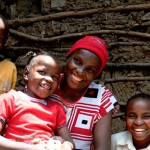A Cote d’Ivoire Workshop Tackles ISOFI Gender Tool
How do you strengthen NGOs’ capacity to integrate gender into their HIV/AIDS communication work? That was the challenge we chose to accept in Cote d’Ivoire. To address this gap in SBCC capacity, we searched the Health COMpass and chose to implement the Inner Spaces, Outer Faces Initiative (ISOFI) Toolkit.
The ISOFI toolkit is made up of participatory group activities that help program staff identify, explore and challenge their own understanding of gender and sexuality in their lives, the lives of project participants and within the organizations in which they work.
We conducted trainings for two local NGOs on gender and sexuality using the five introductory exercises from the ISOFI manual. About 22 male and female participants gathered from each NGO to examine, articulate, and understand their own feelings about gender and sexuality so that they could better incorporate these ideas into their HIV/AIDS work. We designed a pre- and post-test to measure changes.
We found that the ISOFI exercises enabled participants to start overcoming their shame, discomfort and embarrassment in talking about topics related to sexuality. Participants said that ISOFI deeply affected their personal lives and will affect the way they work. They also said that the workshop enabled them to break the silence around sexuality, both in their private lives and in their professional activities.
While the workshops were successful, there is always room for improvement. Based on our experience, we would like to share some lessons learned and offer recommendations to others interested in using this tool.
- The tool is best implemented using a facilitator – not a teacher – approach. For the best response, participants should be prepared for that shift from a classical model to a facilitator model.
- Try using two facilitators – preferably a man and a woman. This allows facilitators to switch off between observing/taking notes, and formally facilitating. It also boosts participation of both sexes.
- To the extent possible, ensure an equal number of men and women. This creates balance and facilitates creation of single-sex groups, which helps ease the feeling of embarrassment surrounding sexuality and gender.
- Participation would improve by recruiting participants who:
- Are about the same age, to increase openness
- Come from a variety of organizations, to reduce chatter and embarrassment
- Have varying levels of education, to encourage brainstorming and thorough analysis
- Icebreakers are critical to lighten the mood
- Be sure to adapt the exercises to the local context and language to make it easy for participants to understand
- Provide clear instructions to participants for what is expected during each exercise. You might consider providing worksheets with a summary of the assignment. It is also important to let participants know how much time they have.
- Watch for participant burnout, especially given the sensitive nature of the topic. We found it emotionally and physically exhausting to conduct exercises 2 and 3 in a half-day. The facilitator(s) must be very comfortable with the topics of gender and sexuality to put the participants at ease.
Visit the Health COMpass to find other great tools like this.








Leave a Reply
Want to join the discussion?Feel free to contribute!